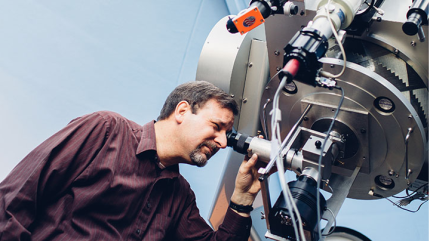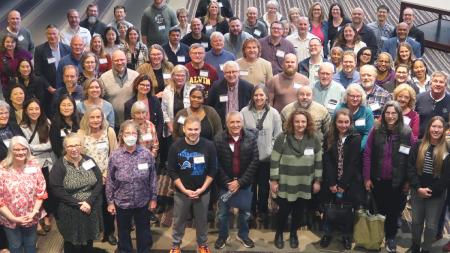Astronomy Prof, Student Predict the Explosion of Two Stars

Larry Molnar at his telescope
Calvin College
Larry Molnar is hoping people will be able to look into the night sky within the next several years and see with their naked eye the creation of a new star.
Since he is a scientist guided by being able to prove theories, the Calvin College astronomy professor is hedging his bets a little.
But Molnar’s best prediction, coming from years of research, is that a binary star — two stars moving in the same orbit — will collide and explode, creating a red nova that should be easily visible for several months to people on earth.
If this happens, it will be the first time a scientist has been able to predict the explosion of a binary star.
“This is certainly very exciting to be part of a project in which we can make a prediction and be able to test it and see if it occurs in the very near future,” said Molnar.
Last week, Molnar was part of a team of astronomers who held a press conference at the American Astronomical Society meeting in Grapevine, Texas, where they announced that they believe the two stars in the constellation Cygnus will crash into one another and create the large red glow, likely sometime in 2022.
News of their announcement has been reported in newspapers, on social media, and in other outlets around the world since then.
“There certainly has been a great deal of interest in this,” said Molnar. “I think that is because this will be among the brightest stars in the sky and will be easily seen even with the lights of a city.”
An archive of the press conference is available at https://aas.org/media-press/aas-press-conference-webcasts.
“It’s a one-in-a-million chance that you can predict an explosion,” Molnar said. “It’s never been done before.”
Molnar’s exploration into the star known as KIC 9832227 began back in 2013. He was attending an astronomy conference when fellow astronomer Karen Kinemuchi presented her study of the brightness changes of the star, and concluded with a question: Is it pulsing, or is it a binary?
Also present at the conference was then Calvin College student Daniel Van Noord, Molnar’s research assistant, who made some observations of the star with the help of the Calvin Observatory.
“He looked at how the color of the star correlated with brightness and determined it was definitely a binary,” said Molnar. “In fact, he discovered it was actually a contact binary, in which the two stars share a common atmosphere, like two peanuts sharing a single shell.
This result brought to mind work published by Polish astronomer Romuald Tylenda, who had studied observational archives to see how another star (V1309 Scorpii) had behaved before exploding unexpectedly in 2008 and producing a red nova.
The pre-explosion record showed evidence of a contact binary with an orbital period decreasing at an accelerating rate. For Molnar, this pattern of orbital change — which they eventually saw in the binary star they were following — was a “Rosetta stone” for interpreting the new data.
Upon observing the period change to continue through 2013 and 2014, Molnar presented orbital timing spanning 15 years at the January 2015 meeting of the American Astronomical Society, making the prediction that KIC 9832227 may be following in the footsteps of V1309 Scorpii.
Before taking the hypothesis too seriously, though, Molnar and his team needed to rule out other, more mundane, interpretations of the orbital change. So they took two years to debunk their hypothesis.
“We did our best to disprove our theory,” said Molnar. “We ruled out every alternative explanation that we could think of. As we did, our confidence built.”
Now that their theory is out there, they will work as best they can to track the course of the binary star as the nuclear fuel in one dies out and the two grow closer and closer until one will theoretically swallow the other.
“We want to take the opportunity to observe the merger of these stars in detail,” said Molnar. “The life cycle of binary stars and how much they interact is rich and varied. There are a variety of things that go on.”
Molnar and colleagues will be observing the stars over the full range of wavelengths, using various telescopes and instruments in the United States and abroad.
“If Larry’s prediction is correct, his project will demonstrate for the first time that astronomers can catch certain binary stars in the act of dying, and that they can track the last few years of a stellar death spiral up to the point of final, dramatic explosion,” said Matt Walhout, dean for research and scholarship at Calvin College.
“The project is significant not only because of the scientific results but also because it is likely to capture the imagination of people on the street,” said Walhout.
Molnar says this is just the beginning of a story that will unfold over the next several years, and people of all levels can participate.
“The orbital timing can be checked by amateur astronomers,” said Molnar. “It’s amazing the equipment amateur astronomers have these days.”
For more about this project, as well as a video, visit red-nova-prediction?dotcmsredir=1.


